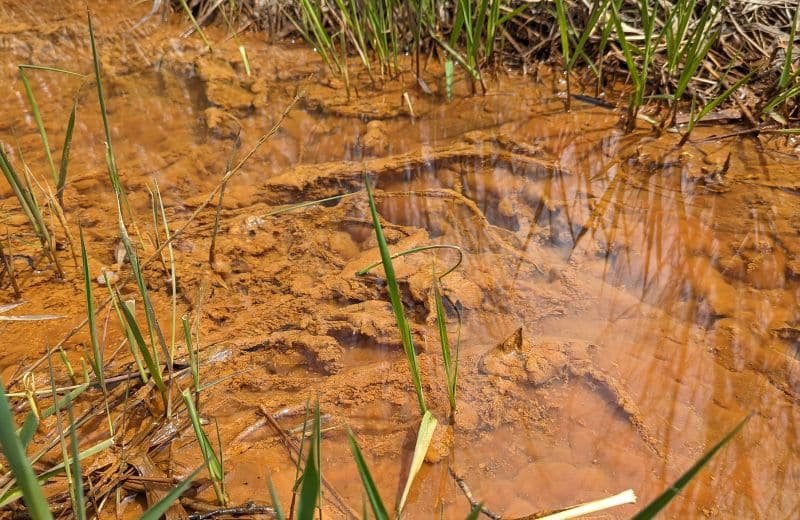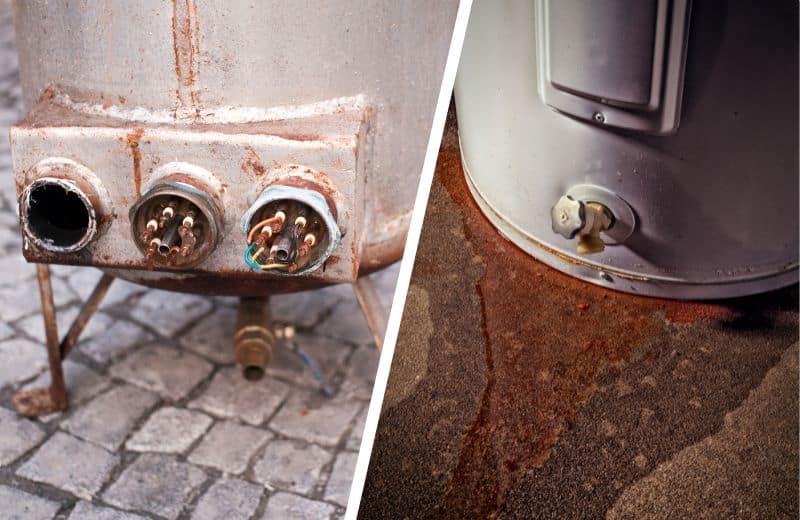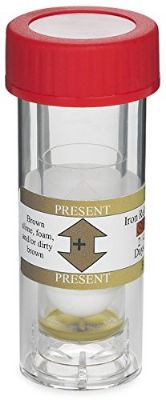Iron is a mineral found in the earth’s crust. When it combines with bacteria to form iron bacteria, it becomes one of the most damaging and difficult-to-remove contaminants in a well water supply.
If you’re dealing with an iron bacteria problem, you might feel like the issue is over your head.
But there’s no need to panic – removing iron bacteria from your water supply is easier than it looks.
If you want clean, safe drinking water that won’t affect your health or damage your home, read on.
Table of Contents
🦠 What is Iron Bacteria?
Iron bacteria is a combination of iron (or manganese), bacteria and oxygen.
You’ll know if these tiny organisms are in your water supply, as they produce sticky, slimy deposits on your well, pipes, plumbing and fixtures.

💥 What Are the Effects of Bacteria Iron?
If you don’t have a lot of iron bacteria in your water, you probably won’t notice its effects at all.
But when bacteria react with high levels of iron, the dissolved iron will oxidize and decay, releasing a slimy, reddish brown material. These deposits can cause a range of effects within your home.
Notably, iron bacteria in well water causes corrosion to pipes and damage to appliances. It may also block your drains.
Plumbing Corrosion
Iron bacteria is a particularly nasty combination when it comes to corrosion. When iron and manganese bacteria oxidize, they produce aggressive ferric chlorides. These can eat away at your metal pipes and plumbing, weakening surfaces and pulling flakes of metal into your water.
Iron bacteria may eventually damage your plumbing enough to cause cracks, holes, and leaks.
Blocked Drains
The thick, slimy substance produced by iron bacteria may leave slime in your plumbing, slowing down your water flow.
This sludge can also form over your drains, eventually resulting in a complete blockage. If you’re constantly clearing slime out of your drains, it’s a good sign that you have an iron bacteria problem.
Damaged Appliances
Finally, it should come as no surprise that iron bacteria can also damage your appliances, including your dishwashers, washing machines and hot water heaters.
When iron bacteria slime builds up on the inside of your appliances, it can clog them up and prevent them from working properly. Iron bacteria slime also acts as a layer of insulation.
This is particularly an issue for your hot water heater, as it’ll have to work harder and longer to heat your water, resulting in reduced efficiency.

👃 How Do I Know If I Have Iron Bacteria in My Water?
Taste and Odor
The taste and odor of your water will be noticeably unpleasant if you have an iron bacteria problem.
Sewage-like or swampy odors are common in water containing iron and manganese. You may also notice a slightly sweet smell, and your water will taste a little like rotting vegetables or fuel.
Additionally, your water may have a rotten egg or sewage like smell, especially if you’re dealing with a high concentration of sulfur.
Water Color
The presence of iron in your water will give it a reddish or brownish tinge. Dissolved iron oxidizes when it comes into contact with oxygen in the air. It’s the rust-colored oxides that form as a result that you will notice in your water.
Check the inner surfaces of your toilet tank for confirmation of an iron problem. This is a particularly common location for iron bacteria to show themselves.
Slimy Deposits
Slimy deposits are the next step up from having a rust-like tint to your water. These deposits are caused by decaying iron oxides, and may float on the surface of your water or stick to surfaces.
Again, check your toilet tank for this sign of oxidation of iron. If iron bacteria has been allowed to build up over time, you will notice it sticking to the inside of the tank. You may also see an oily sheen on the top of your water.
These deposits can become a big problem in your toilet tank over time, and you may need to dump the tank’s contents and start again.
🧫 How to Test For Iron Bacteria
If you think you have iron bacteria in your water, it’s worth testing your water to determine exactly what you’re dealing with.
The most suitable test for this purpose is the BART (Biological Activity Reaction Test). You can use this type of testing for detecting iron bacteria, as well as sulfur bacteria, another common well water contaminant.
The advantage of the BART is that it doesn’t cost too much money, and is a lot more affordable than sending your water off to a laboratory. You also don’t need a microscope, incubator or any kind of science set-up at all to run the test.
For the most accurate results, you should test your water at room temperature.
The BART uses a plastic tube that contains a small ball. The vial’s bottom surface contains a kind of crystallized media that’s designed to test for each type of bacteria.

When you add a water sample to the tube, the crystalized media will dissolve, sending the ball up to float on the top of the water. The ball will produce a gradient of oxygen levels, with anaerobic organisms (those that don’t require oxygen to grow) at the bottom, and oxygenic organisms (those that require O2 to grow) at the top.
You can use the BART to detect the presence of iron bacteria, and determine their overall activity levels. Testing kits usually cost around $40 to $50. You’ll need patience when using the BART, as most kits recommend checking up on your water every day for 8 days.
An alternative to at-home bacteria tests is to send a sample of your water off to a certified laboratory for in-house testing.
This will cost you more money, but will usually provide slightly more accurate results. In 2025 I recommend Tap Score as the best lab test available 👇

✔️ How to Remove Iron Bacteria From Well Water
There are a number of methods and treatments designed specifically to remove iron bacteria from private well water supplies. These may use physical removal, shock chlorination, and continuous disinfection.
Physical Removal
The initial iron bacteria treatment stage is physical removal. A professional plumber or handyman is the best person to hire for this job.
First, your well equipment will be removed and cleaned. A plumber will also scrub out the inside of your well casing and prepare the system for chemical treatment.
Shock Chlorination
If you’re dealing with a particularly nasty iron bacteria problem, shock chlorination may be the most suitable option for you.
This method will get rid of the majority of bacteria straight away. If iron bacteria has been building up over a period of months or years, shock chlorination is powerful enough to tackle the issue.
Shock disinfection with chlorine involves circulating household bleach or a similar disinfectant through well water systems and household plumbing. One-to-two weeks after implementing this treatment, you should test your well water again to determine your bacteria concentration.
Note that chlorine might be cheap, but it isn’t always the most effective. You may have to use chlorine more than once to treat your well. Make sure you use the right concentration of chlorine to effectively tackle the issue.
You can use between ~ 200 PPM chlorine to address iron and sulfur bacteria. You may need to shock your system 2-3 times per year if not using a continuous disinfection system.
Continuous Disinfection
Shock chlorination can remove the majority of iron bacteria from water. However, this type of water treatment may not be able to reach all the bacteria, as it’s common for it to build up in layers of deposits.
Extended, long-term contact with a disinfectant is required to kill bacteria and keep it at bay.
This method follows these steps:
1) Chemical Injection
Chemical injection is one of the most common and effective means of removing iron bacteria in the long run.
This water treatment process uses the same method as a municipal water supplier. The system injects a chemical – usually chlorine – into your water, which acts as a disinfectant, killing iron bacteria and similar organisms.
2) Retention
After injection, your drinking water will have to sit in a storage tank for several minutes before it can be used.
Chlorine can’t kill bacteria immediately. Rather than heading straight into your home, water will be held in a retention tank for long enough for the chlorine to do its job. The size of this tank will determine how much water you will have access to at any given time.
3) Filtration
The final stage in continuous disinfection is to filter out the water’s contaminants, including bacteria and oxidized metals, and disinfectant chemicals.
Further Reading: Check out my guide on how to remove ferric and ferrous iron here 👈
